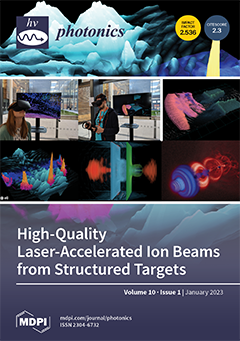Liquid-assisted laser processing (LALP) is implemented using a 10.6 μm continuous-wave (CW) CO
2 laser to drill holes in 1.1 mm thick soda-lime glass substrates fully immersed in a nanoliquid bath. The nanoliquid bath consisted of de-ionized water and carbon nano-particles (CNPs) of different wt.%. The study focuses on the influence of exposure time (T
E, [s]), laser beam power (P, [W]) and number of pulses (N
P) on resulting geometrical features, namely, crack length (CL, [mm]), inlet diameter (D
INLET, [mm]) and exit diameter (D
EXIT, [mm]). The processed samples were characterized using an optical microscope. Findings show that LALP with investigated ranges of control parameters T
E (0.5–1.5 s), P (20–40 W) and N
P (1–6 pulses) led to successful production of drilled holes having CL range (0.141 to 0.428 mm), D
INLET range (0.406 to 1.452 mm) and D
EXIT range (0.247 to 1.039 mm). It was concluded that increasing T
E alone leads to increasing CL, D
INLET and D
EXIT, while keeping a good balance among the control parameters, especially T
E and N
P, will result in reduced CL values. Moreover, process statistical models were developed using statistical analysis of variance (ANOVA). These models can be used to further understand and control the process within the investigated ranges of control and response parameters.
Full article





